Once again this post is not for everyone. But I kinda think you like it when I start a post that way. That’s because you all are my kind of people. And we like to talk about real life stuff. And often times that “stuff” is gross… and this post definitely falls into that category, even for me. Now that we have the warning out of the way, let’s get to it. On the ranch, we’ve been preg checking cattle. That’s right we manually have to check to see if the cows/heifers are pregnant. And it aint pretty people! But let’s begin this story back in June when the cows and heifers are put in the pasture for 90 days with this guy. Well, this guy and about 25 of his friends. 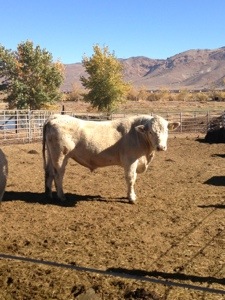 The bulls have 3 months to impregnate 500 head of cattle. Tough job but someone has to do it. The cows then live happily eating and sleeping, like every pregnant woman wishes she could do. But how do you know if they are actually bred? That brings us back to the title of this post. We preg check them. And here’s how. One at a time, we bring all 500 of them into the squeeze chute.
The bulls have 3 months to impregnate 500 head of cattle. Tough job but someone has to do it. The cows then live happily eating and sleeping, like every pregnant woman wishes she could do. But how do you know if they are actually bred? That brings us back to the title of this post. We preg check them. And here’s how. One at a time, we bring all 500 of them into the squeeze chute.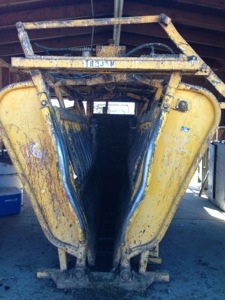 It’s the name of the machine that holds them in place so they can’t move. Pretty much the same as the “stirrups” for all us woman in the OBGYN office. Steve, Darrin’s brother, is a large animal veterinarian. So on days like this, he’s in charge. And he’s teaching Eva and Domi the ropes.
It’s the name of the machine that holds them in place so they can’t move. Pretty much the same as the “stirrups” for all us woman in the OBGYN office. Steve, Darrin’s brother, is a large animal veterinarian. So on days like this, he’s in charge. And he’s teaching Eva and Domi the ropes.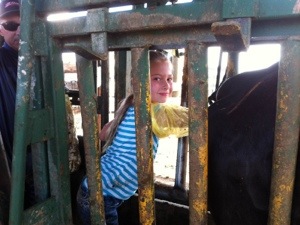 They wear full arm length gloves and then slowly inset their hands into the cows’ rectum. YYYYYEEEEEOUCHHHHH!!! Once their entire arm is inside the animal, they feel through the rectal wall down on top of the uterus. In the earliest stages of pregnancy, they’re feeling for membrane fluid. By 30 days pregnant, the calf is the size of a pea. At 2 months it’s the size of a mouse. And at 3 months, the size of a rat. Between 3-7 months, it’s actually harder to feel the calf because the pelvis wall gets in the way. During that time frame, they will feel for arteries. Each check last less than a minute. Ok, now all us moms have been “preg checked” before… but it was done in a sterile doctor’s office with a slender probe… AND IT STILL SUCKED! But we have nothing to complain about when compared to a cow.
They wear full arm length gloves and then slowly inset their hands into the cows’ rectum. YYYYYEEEEEOUCHHHHH!!! Once their entire arm is inside the animal, they feel through the rectal wall down on top of the uterus. In the earliest stages of pregnancy, they’re feeling for membrane fluid. By 30 days pregnant, the calf is the size of a pea. At 2 months it’s the size of a mouse. And at 3 months, the size of a rat. Between 3-7 months, it’s actually harder to feel the calf because the pelvis wall gets in the way. During that time frame, they will feel for arteries. Each check last less than a minute. Ok, now all us moms have been “preg checked” before… but it was done in a sterile doctor’s office with a slender probe… AND IT STILL SUCKED! But we have nothing to complain about when compared to a cow.
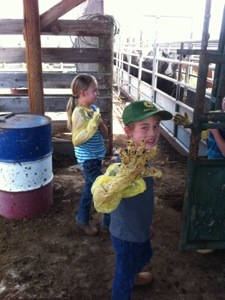 So once their exam is over, the bred cows (the ones who have had a baby) are turned back out to pasture. The bred heifers (the ones who haven’t had a baby and need to be watched while delivering) will stay at the home ranch. The “open” cows that didn’t get bred will be put into the Fall herd for one more chance. They will be marked with a white ear tag so Darrin knows they didn’t get pregnant the first go around. If they don’t get pregnant in the Fall they will be sold. Total gestation period is 9 1/2 months. So come Spring, we’ll start “calving out.” Stay tuned! I’ll bring you up close and personal with the delivery of a calf. And I’ll probably begin that story with… “This post is not for everyone!!”
So once their exam is over, the bred cows (the ones who have had a baby) are turned back out to pasture. The bred heifers (the ones who haven’t had a baby and need to be watched while delivering) will stay at the home ranch. The “open” cows that didn’t get bred will be put into the Fall herd for one more chance. They will be marked with a white ear tag so Darrin knows they didn’t get pregnant the first go around. If they don’t get pregnant in the Fall they will be sold. Total gestation period is 9 1/2 months. So come Spring, we’ll start “calving out.” Stay tuned! I’ll bring you up close and personal with the delivery of a calf. And I’ll probably begin that story with… “This post is not for everyone!!”

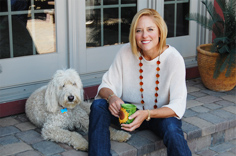
Sierra and I enjoyed the article. I liked the sense of humor infused into your writing… Sierra liked the cows… She loved seeing the “ranch work” being done by children near her age. I asked her to write down all the words she did not understand, and then we would “Google” them to find their meanings. This is what she wrote down.
Heifers. Impregnate. OBGYN. Rectum. Rectal. Uterus. Membrane. Gestation…
The expressions “I stuck my foot in my mouth” and “opened up a can of worms”… can be inserted right here… =)
thats hilarious Greg!! thanks for checking out my blog!!